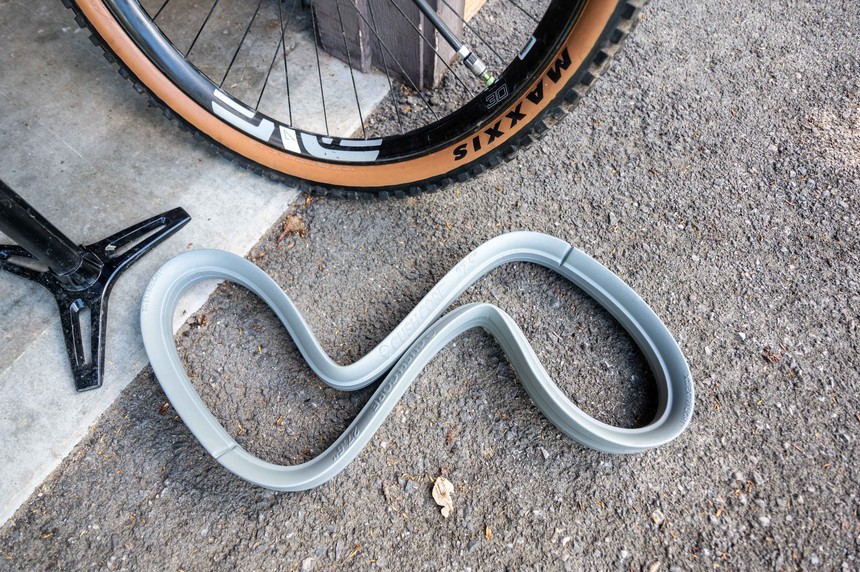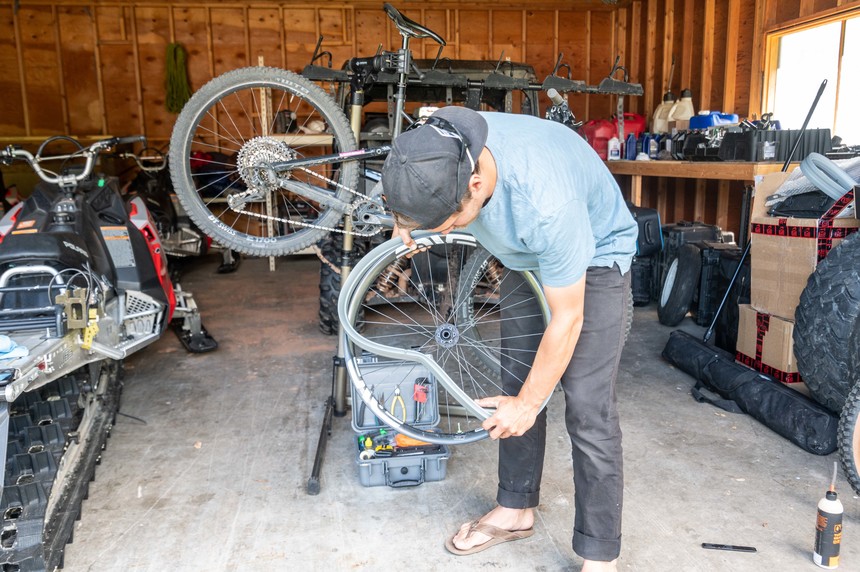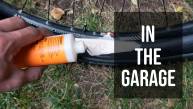 For Episode 3 of In the Garage, we're doing a little deep dive into bike tech. Max Ritter photo.
For Episode 3 of In the Garage, we're doing a little deep dive into bike tech. Max Ritter photo.
The bike world is all about incremental improvements. A few millimeters here and a few degrees there promise to improve your ride ever so slightly over the last iteration. But every now and then, something comes along that truly does fundamentally change the way a bike rides on the trail. Okay, I’ll admit that tire inserts are nothing new – hey just a few years ago EVERYONE was running a form of them (remember inner tubes?) – but surprisingly they still seem to be a relatively niche piece of kit. These days, there are few viable options on the market like Schwalbe’s Pro Core system, which we reviewed last summer, or the popular Cush Core inserts. Each works slightly differently, but the basic idea is the same: they provide an extra layer of protection between your tire and the rim, allowing you to run much lower tire pressures for extra traction and give you peace of mind when you hit something going a little too fast.
RELATED: In the Garage - What's in The Tool Box?
Ok, so what’s wrong with my standard wheel/tubeless tire combination?
Nothing is “wrong” with it; but run low enough pressures for proper traction and riding aggressively in chunky and rocky terrain will almost certainly lead to a flat tire. That’s where the tire insert comes in. Whether it’s a foam insert like Cush Core or an actual innertube like Schwalbe’s Pro Core, my tire never contacts the sharp rim edge when I hit something pointy. See below for what I mean by “hitting something pointy.” That’s called a pinch flat, and they are evil, because they often leave holes bigger than what sealant can fill and can damage my rim.
 Low pressures and sharp cornered things on the trail tend to cause problems. Not with a tire insert like Cush Core. Max Ritter photo.
Low pressures and sharp cornered things on the trail tend to cause problems. Not with a tire insert like Cush Core. Max Ritter photo.
How will it improve my riding?
A tire insert will provide two things: the ability to run lower tire pressures and peace of mind. I’ve been able to run sub-20 psi pressures in lighter-casing tires without any issues of flatting or tire roll. Cush Core’s shape actually supports the tire’s sidewall, meaning it won’t roll as much as a standard tubeless tire at low pressure. Secondly, the low pressures give me exponentially more traction in the loose and dusty conditions, like those found in the Tetons all summer long. That means I find myself going faster through corners, off-camber sections, and through tech.
The flat protection is really where this system shines. Having the ability to huck into rock gardens or roll over sharp edges without a worry has totally changed the game for me. There’s a reason some of the fastest racers in the world use it (Richie Rude, Loic Bruni, Wyn Masters, to name a few). When it comes to not holding back on the bike, every little bit extra counts.
 The insert takes up a fair amount of volume in your tire and will help support sidewalls and prevent rim damage. Max Ritter photo.
The insert takes up a fair amount of volume in your tire and will help support sidewalls and prevent rim damage. Max Ritter photo.
Finally, if I do flat and find myself without a repair kit, I could limp back to the trailhead on just the insert and empty tire. It wouldn’t be pretty, but I certainly can’t do that on bare rim.
How do I install it?
Installing a system like this can be a bit of a pain, and it’s certainly not as straightforward as simply installing a tubeless tire but follow the directions with any brand’s packaging and it should work fine. Cush Core goes in a little easier than most inserts, as the foam material is stretchy enough to pull over your rim to seat. I found the hardest part to be seating the actual tire over the insert, but by my second install I figured out all it takes is a little more elbow grease.
 Installing the inserts requires a bit patience and a little elbow grease. Max Ritter photo.
Installing the inserts requires a bit patience and a little elbow grease. Max Ritter photo.
What are the downsides?
In all honesty, there are two downsides to running any sort of insert. You suffer a slight weight penalty where it matters most (rotating weight on your wheels makes it harder for your bike to accelerate/decelerate). Though this could be remedied by running a lighter weight tire. Secondly, if you do end up slashing your sidewall on the trail and want to pop a tube in to get back home, you’re stuck with removing the insert so you have room to fit your tube. Not a big deal, considering you could likely ride home on the insert and empty tire, but something to think about.
Cush Core vs. Schwalbe Pro Core
Over the past few months of riding, I’ve been comparing Cush Core to Schwalbe’s Pro Core to gauge their differences and what might make a better system for your riding style. Let me state that both are incredibly useful systems, and each has its own advantages.
Cush Core is a set it and forget it kind of system. Pop the foam insert into your tire, and that’s it. It’s peace of mind in the form of simplicity. I would recommend it for those who thrash their bikes on jumps or in bike parks day in and day out.
Schwalbe’s Pro Core offers a little more adjustability, as you can set pressures differently in the inner tube and main air chamber to fine-tune your ride feel. It’s not something I find myself doing very often, but does make a difference. It’s also slightly heavier, so pairs well with a lighter-casing tire.
The Bottom Line:
If you hate flats, ride fast and aggressively, and want a worry-free experience on the bike, consider tire inserts. More than any brake, suspension, or drivetrain upgrade, these things will make you faster.












